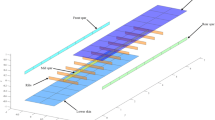Abstract
Determining the characteristics of wind gusts that result in the critical loading of an aircraft structure is an extremely complex problem. On the other hand, identifying these “worst-case gusts” is terribly important for aircraft designers because they need to ensure that aircraft are designed to withstand the dynamic loads associated with these turbulent gusts. In this paper an evolutionary algorithm (EA) is shown to be a feasible approach to solving this problem. The EA outperforms a traditional method suitable for solving linear problems, then is extended to nonlinear problems for which there is no effective solution methodology.
Similar content being viewed by others
References
R. Wingrove and R. Bach, “Severe turbulence and maneuvering from airline flight records,” Journal of Aircraft, vol. 31, no. 4, pp. 753-760, 1994.
G.-C. Zha, D. Smith, M. Schwabacher, K. Rasheed, A. Gelsey, D. Knight, and M. Haas, “High performance supersonic missile inlet design using automated optimization,” Journal of Aircraft, vol. 34, no. 6, pp. 697-705, 1997.
K. Rasheed and H. Hirsh, H. “Learning to be selective in genetic-algorithm-based design optimization,” Artificial Intelligence for Engineering Design, Analysis and Manufacturing, vol. 13, pp. 45-61, 1999.
M.F. Bramlette and E.E. Bouchard, “Genetic algorithms in parametric design of aircraft,” in Handbook of Genetic Algorithms, edited by L.D. Davis, Ch. 10, 1991, pp. 109-123.
B. Etkin, “Turbulent wind and its effect on flight,” Journal of Aircraft, vol. 18, no. 5, pp. 327-345, 1981.
J.G. Jones, A Relationship between the Power-Spectral-Density and Statistical-Discrete-Gust methods of Aircraft Response Analysis, Royal Aircraft Establishment, Farnborough, England, UK, RAE TM Space 347, 1984.
D.O. Northy, Analysis of the Factors which Determine Signal/Noise Discrimination in Radar, RCA Lab., Princeton, NJ, Rept. PTR-6C, June 1943.
T.A. Zeiler, “Matched filter concept and maximum gust loads,” AIAA Journal of Aircraft, vol. 34, no. 1, 1997.
J.G. Jones, Aircraft Response to Turbulence: Recent Research Using a Wavelet Model, Presented at Gust Specialists Meeting, Dallas, Texas, April 15, 1992.
J.G. Jones, G.W. Foster, and P.G. Earwicker, “Wavelet analysis of gust structure in measured atmospheric turbulence data,” AIAA Journal of Aircraft, vol. 30, pp. 94-99, 1993.
J.G. Jones, Statistical Discrete Gust Theory for Aircraft Loads, Royal Aircraft Establishment, Farnborough, England, UK, RAE TR-73167, 1973.
J.G. Jones, “Statistical discrete gust method for predicting aircraft loads and dynamic response,” Journal of Aircraft, vol. 26, no. 4, pp. 382-392, 1989.
G. Rosenberg, D.A. Cowling, and M. Hockenhull, “The deterministic spectral procedure for gust response analysis of nonlinear aircraft modes,” Stirling Dynamics Ltd. Report No. 233. International Forum on Aeroelasticity and Dynamics, Strasbourg, France, May 1993.
R. Mehrotra, “Analysis of worst-case gust loading on aircraft structures using a genetic algorithm,” M.S. Thesis: The University of Alabama, 2001.
C.L. Karr and E. Wilson, “Aself-tuning evolutionary algorithm,” Paper submitted for publication, 2001 (submitted).
T.P. Hong, H.S. Wang, and W.C. Chen, “Simultaneously applying multiple crossover and mutation operators,” in Proceedings of the Genetic and Evolutionary Computation Conference, vol. 1, 1999, pp. 790.
J.J. Grefenstette, “Optimization of control parameters for genetic algorithms,” IEEE Transactions on System Man, and Cybernetics, vol. SMC-16, no. 1, pp. 122-128, 1986.
Y. Davidor, “Analogous crossover,” in Proceedings of the Third International Conference on Genetic Algorithms, 1989.
D. Jong, “Adaptive system design: A genetic approach,” IEEE Transactions on Systems, Man, and Cybernetics, vol. 10, pp. 566-574, 1980.
Rights and permissions
About this article
Cite this article
Karr, C.L., Zeiler, T.A. & Mehrotra, R. Determining Worst-Case Gust Loads on Aircraft Structures Using an Evolutionary Algorithm. Applied Intelligence 20, 135–145 (2004). https://doi.org/10.1023/B:APIN.0000013336.08029.0c
Issue Date:
DOI: https://doi.org/10.1023/B:APIN.0000013336.08029.0c




